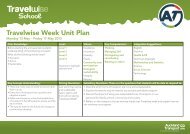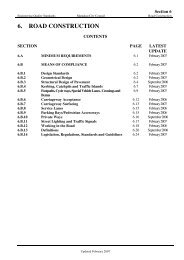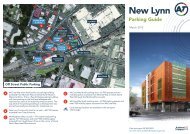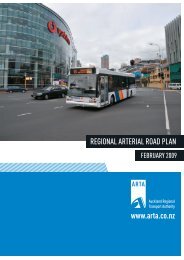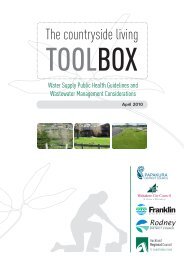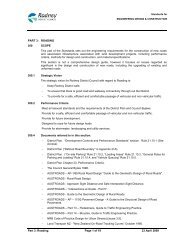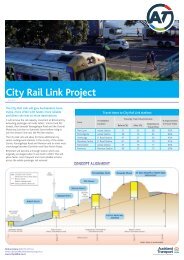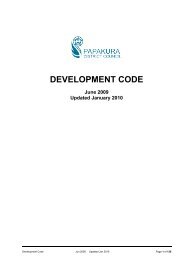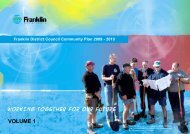Regional Land Transport Programme 2009 - 2010 (2MB) - Auckland ...
Regional Land Transport Programme 2009 - 2010 (2MB) - Auckland ...
Regional Land Transport Programme 2009 - 2010 (2MB) - Auckland ...
You also want an ePaper? Increase the reach of your titles
YUMPU automatically turns print PDFs into web optimized ePapers that Google loves.
When taking into account the population and size of previous<br />
allocations, the majority of requests for funding for the <strong>Auckland</strong><br />
region’s activity classes appear reasonable, however, the following<br />
activity classes need further discussion:<br />
> Over 60% of the national allocation for public transport services<br />
is requested for the <strong>Auckland</strong> region. <strong>Auckland</strong> is experiencing a<br />
huge growth in public transport patronage which is supporting<br />
investment in the roading system by attracting trips that would<br />
have been made on congested arterials and motorways. The<br />
public are also demanding better services after many years of<br />
under-investment. <strong>Auckland</strong> suffers from peak-hour congestion<br />
to a much greater extent than other cities in New Zealand and it<br />
is public transport which is the most efficient mode to transport<br />
commuters in congested conditions – especially the rapid transit<br />
busway and rail networks. Due to a shortfall in local share for<br />
public transport services, ARTA has reduced the request for<br />
national share by $51 million between the draft and the final<br />
RLTP. Any further reduction in public transport service funding<br />
would put at risk the increases in patronage recently experienced<br />
and would threaten the GPS impact of improved national<br />
economic growth and productivity by increasing congestion on<br />
arterial roads and motorways.<br />
> The <strong>Auckland</strong> region over-subscribes the national allocation for<br />
walking and cycling facilities, consequently it is likely the NZTA<br />
will only fund higher-priority activities. Around a quarter of all<br />
walking and cycling projects are NZTA HNO projects. Often,<br />
walking and cycling schemes associated with motorways are<br />
necessary to mitigate the barrier effects to movement on<br />
pedestrians and cyclists created by the building of the motorway.<br />
In these cases, where the purpose of the scheme is to mitigate<br />
the negative effects of the motorway, whether the motorway is<br />
existing or proposed, the costs of these schemes should be borne<br />
by the New and Improved Infrastructure for State Highway<br />
activity class as opposed to the Walking and Cycling activity class.<br />
This would reduce the over-subscription in walking and cycling<br />
facilities. ‘R’ funds would be an appropriate funding source to<br />
support projects in this activity class, as walking and cycling are<br />
the most effective mode for decongesting roads for short trips.<br />
> The Public <strong>Transport</strong> Infrastructure activity class is substantially<br />
over-subscribed. This is due to the reduction in allocation from<br />
the 2008 GPS to the <strong>2009</strong> GPS and the decision not to proceed<br />
with the regional fuel tax. The <strong>Auckland</strong> region’s request for<br />
funding, at the invitation of the Government, includes rail<br />
stations, which had not previously been expected to be funded<br />
through this activity class. This infrastructure is essential for<br />
<strong>Auckland</strong> transport network and funds must be made available,<br />
especially as many of the projects are necessary for the Rugby<br />
World Cup 2011. Discussions are currently underway between<br />
regional and government funding agencies to resolve the funding<br />
of <strong>Auckland</strong>’s rail upgrade.<br />
These issues are discussed more fully in the following section which<br />
summarises the RLTP by activity class.<br />
Summary of the RLTP by Activity Class<br />
The full list of prioritised projects for this RLTP is contained in<br />
Chapter 10. The following section summarises the key aspects of the<br />
RLTP by activity class including:<br />
> Key projects.<br />
> Important issues affecting the successful implementation of<br />
projects.<br />
> Recommendations on the allocation of funding across activity<br />
classes.<br />
Newmarket development<br />
26



